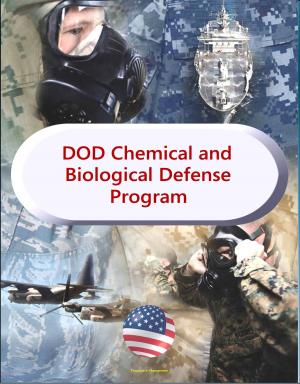U.S. Army War College Guide to National Security Policy and Strategy: Second Edition, Revised and Expanded
Nonfiction, Social & Cultural Studies, Political Science, Politics, Arms Control, Science & Nature, Technology, Military Science| Author: | Progressive Management | ISBN: | 9781458070401 |
| Publisher: | Progressive Management | Publication: | June 2, 2011 |
| Imprint: | Smashwords Edition | Language: | English |
| Author: | Progressive Management |
| ISBN: | 9781458070401 |
| Publisher: | Progressive Management |
| Publication: | June 2, 2011 |
| Imprint: | Smashwords Edition |
| Language: | English |
This edition of the U. S. Army War College Guide to National Security Policy and Strategy reflects to some extent recent changes in the structure of the core curriculum at the War College. The college broke its traditional core course, “War, National Policy and Strategy,” into two courses: “Theory of War and Strategy” and “National Security Policy and Strategy.” The result for this book is the expansion of the block on strategic theory and the introduction of a block on specific strategic issues. Because little time has past since the publication of the most recent version of this book, this edition is largely an expansion of its predecessor rather than a major rewriting. Several chapters are new and others have undergone significant rewrites or updates, but about two-thirds of the book remains unchanged. Although this is not primarily a textbook, it does reflect both the method and manner we use to teach strategy formulation to America’s future senior leaders. The Guide is organized in broad groups of chapters addressing general subject areas. We begin with a look at some specific issues about the general security environment—largely international. The section on strategic thought and formulation includes chapters on broad issues of strategy formulation as well as some basic strategic theory. The third section is about the elements of national power. A section on the national security policymaking process in the United States precedes the final section that deals with selected strategic issues.
Contents include: The National Security Environment, The International System in the 21st Century, Multilateralism and Unilateralism, Ethical Issues in War: An Overview, Ethics and War in Comparative Religious Perspective, International Law and the New World Order: Redefining Sovereignty, Regional Studies in a Global Age, Strategic Theory and Formulation, A Survey of the Theory of Strategy, Toward a Theory of Strategy: Art Lykke and the Army War College Strategy Model, Why is Strategy Difficult?, National Power, Managing Strategic Risk, Landpower in Traditional Theory and Contemporary Application, Thucydides and Contemporary Strategy, Elements of Power, Diplomacy as an Instrument of National Power, Theory and Practice of Modern Diplomacy: Origins and Development to 1914, Information: The Psychological Instrument, Military Power and the Use of Force, Economics: American Element of Power or Source of Vulnerability?, Problems of Economic Statecraft: Rethinking Engagement, National Security Policymaking, National Security and the Interagency Process, National Security Powers: Are the Checks in Balance?, National Military Strategies: 1990 to 2005, Appropriate Role of Intelligence in the Making of National Security Policy , Cognitive Factors in National Security Decisionmaking, Strategic Issues, Air Power Theory: An Analytical Narrative from the First World War to the Present, John Warden’s Five Ring Model and the Indirect Approach to War, Network-Centric Warfare: Just about Technology?
This edition of the U. S. Army War College Guide to National Security Policy and Strategy reflects to some extent recent changes in the structure of the core curriculum at the War College. The college broke its traditional core course, “War, National Policy and Strategy,” into two courses: “Theory of War and Strategy” and “National Security Policy and Strategy.” The result for this book is the expansion of the block on strategic theory and the introduction of a block on specific strategic issues. Because little time has past since the publication of the most recent version of this book, this edition is largely an expansion of its predecessor rather than a major rewriting. Several chapters are new and others have undergone significant rewrites or updates, but about two-thirds of the book remains unchanged. Although this is not primarily a textbook, it does reflect both the method and manner we use to teach strategy formulation to America’s future senior leaders. The Guide is organized in broad groups of chapters addressing general subject areas. We begin with a look at some specific issues about the general security environment—largely international. The section on strategic thought and formulation includes chapters on broad issues of strategy formulation as well as some basic strategic theory. The third section is about the elements of national power. A section on the national security policymaking process in the United States precedes the final section that deals with selected strategic issues.
Contents include: The National Security Environment, The International System in the 21st Century, Multilateralism and Unilateralism, Ethical Issues in War: An Overview, Ethics and War in Comparative Religious Perspective, International Law and the New World Order: Redefining Sovereignty, Regional Studies in a Global Age, Strategic Theory and Formulation, A Survey of the Theory of Strategy, Toward a Theory of Strategy: Art Lykke and the Army War College Strategy Model, Why is Strategy Difficult?, National Power, Managing Strategic Risk, Landpower in Traditional Theory and Contemporary Application, Thucydides and Contemporary Strategy, Elements of Power, Diplomacy as an Instrument of National Power, Theory and Practice of Modern Diplomacy: Origins and Development to 1914, Information: The Psychological Instrument, Military Power and the Use of Force, Economics: American Element of Power or Source of Vulnerability?, Problems of Economic Statecraft: Rethinking Engagement, National Security Policymaking, National Security and the Interagency Process, National Security Powers: Are the Checks in Balance?, National Military Strategies: 1990 to 2005, Appropriate Role of Intelligence in the Making of National Security Policy , Cognitive Factors in National Security Decisionmaking, Strategic Issues, Air Power Theory: An Analytical Narrative from the First World War to the Present, John Warden’s Five Ring Model and the Indirect Approach to War, Network-Centric Warfare: Just about Technology?















